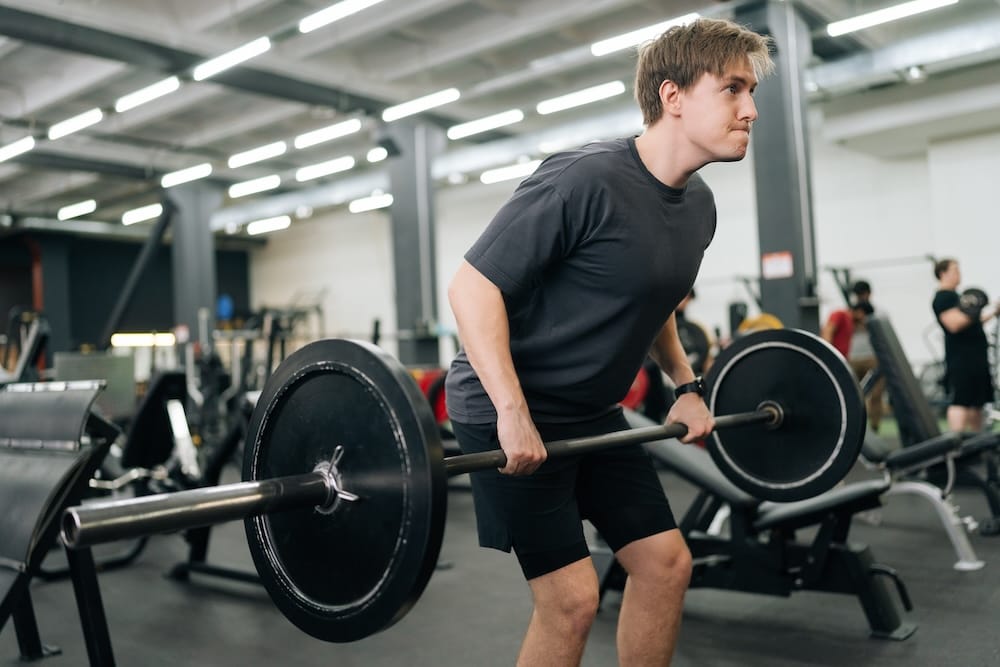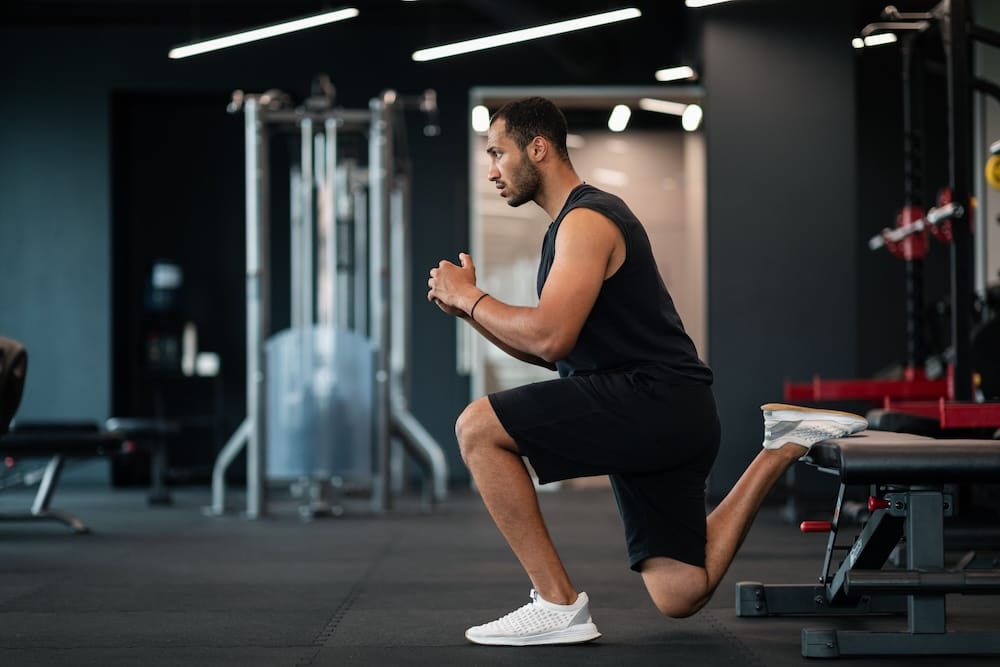Is the Bro Split Workout Effective for Muscle Growth?
Understand the bro split workout training method. See how the frequency of your training impacts muscle growth.

Hitting the gym with your bros has got to be one of the best feelings in the world.
Just some chill time with your buddies and the heaviest weights possible. But is bro splitting with your bros a serious way to build muscle or just a hype technique that will waste your time?
In this article, we’re unpacking the bro split. You’ll learn how this training program cycles throughout a typical week and what the pros and cons of a bro split are.
Plus, the bro split is more effective for some gymgoers than others. See who those people are and why it works for some but not for all. And get to know whether the bro split would be a useful training method to suit your gym goals.
Read on to learn more about the bro split workout.
What is the bro split?
The bro split means training by muscle group. Usually, lifters pick one muscle group to concentrate on each day, cycling them out throughout the week.
For example, on a bro split plan, you might train:
- Monday: Chest
- Tuesday: Back
- Wednesday: Legs
- Thursday: Arms
- Friday: Shoulders
- Saturday/Sunday: Rest
If there’s an area you’re struggling to grow as well, you can add it on as a secondary muscle group under the bro split.
So for example, if you want to train a secondary muscle group, you could do something like this:
- Monday: Chest & Triceps
- Tuesday: Back & Biceps
- Wednesday: Legs
- Thursday: Arms & Calves
- Friday: Shoulders & Abs
- Saturday/Sunday: Rest
Adding a second muscle group to hit on specific training days offers you more volume if you’re struggling to grow a certain body part.
The bro split is an example of what we call a “body part split.” That just means you’re grouping your workouts by body part.
Other body part splits include:
Whole Body Split

This is usually used as a simple beginner split or by people who don’t work out daily.
A whole-body workout split means you work all the major muscle groups of the body on a single day. Here, you’d hit your legs, abs, arms, back, and shoulders all at once.
Although it seems like a lot, if your schedule is too busy to allow you to work out and optimize each muscle group by day, a total body split is still an effective way to get in a workout.
Upper-Lower

This entails working the upper half of your body (arms, chest, back, shoulders, etc.) and your lower (legs) on alternating days.
Sometimes people choose to divide upper-lower splits breaking down their upper days into “push” muscles and “pull” muscles.
So for example, on Monday you would train your chest and shoulders (push), Tuesday legs, Wednesday you train your biceps and back (pull), Thursday, legs, then back to the push muscles for Friday.
Saturday might be a rest day and then you’d train the “pull” muscles again on Sunday.
This is just one way that people can break down an upper-lower split. If you prefer, you can do the full upper body, alternating it in and out with legs.
Push Pull Legs (PPL)

The same principle applies to push-pull-legs splits as to upper lower, only you rotate between three elements rather than just two.
So for example, you may train:
- Monday: Push
- Tuesday: Pull
- Wednesday: Legs
- Thursday: Rest
- Friday: Push
- Saturday: Pull
- Sunday: Legs
Why are they called bro splits?
This split rose to prominence with archetypal “gym bros” and recreational bodybuilders.
And there’s no shame in that if this is you! The split has proven to be effective for that demographic. Chances are, you’ve seen some of the biggest guys at your gym training with this pattern.
The bro split receives a lot of flack online. Take a look at a few of the anti-bro criticisms that have been levied against this routine and see whether they’re backed by science and results.
Why does everyone hate the bro split?
Maybe it’s the name association but people love to rag on the bro split.
It’s been called “useless” by many a lifter, namely because you only get to train each muscle group once a week (unless you double up on certain days).
But is the hate unwarranted?
Fitness creator Jeff Nippard has a BSc in biochemistry/chemistry and analyses exercise methods through a scientific lean.
He’s used a bro split type routine and unpacking the science, he found it no less effective than any other type of workout for maximizing muscle hypertrophy (muscle growth). Check out what he had to say on the subject.
But for everyone who is “pro bro,” there are just as many naysayers.
Take a look at some pros and cons of the bro split and decide for yourself whether this training style seems convenient for you.
Bro Split Pros
On the plus side, the bro split offers you:
- Focus: You get to focus on only one muscle group at a time, no distractions. If you find you tend to flip between muscle groups or exercises aimlessly, the bro split may be a more effective option for you to focus your mental energy on only doing one thing at a time.
- Recovery Time: You get nearly a week off between training sessions for each muscle. If you’re someone who gets easily fatigued, this gives you ample time to rest, relax and recover. Make sure to stretch during your downtime. You can read up on some rest, stretch and recovery techniques here to see if they’re right for you. Check out: Is Ballistic Stretching Safe?, What is Muscle Scraping, and Psoas Exercises for Pain Relief
Cons
- Not Time Efficient: Many people consider the bro split a massive time waster.
Because each muscle group is trained in a fashion that’s so spread out, spending an hour on only arm exercises can feel daunting and seem like a waste of time. Furthermore, you only train each major muscle group about once a week. Some people consider this way too little if you want to get results quickly and are looking to get a lean bulk going quickly.
- Too Much Time Between Training Sessions: With a bro split, you’re leaving almost a week between sessions for training each muscle group. Unless you’re maximizing every minute of your devoted training day to whichever muscle, you’re probably not getting as much overall training volume.
- Not Training With Fresh Muscles: Say you’re working on your shoulders. Over the course of an hour-long training session, your shoulders are going to fatigue. Your last set will probably be sloppier than your first. It’s not a bad thing to train to failure of to work tired muscles. Over time this can help you become more tenacious with your workouts. But there is something to be said for training a muscle group when it feels completely fresh. You’ll probably notice the ability to lift heavier weights and perform longer sets if an exercise is the first thing you do, rather than the last. By hitting the muscle groups multiple times per week, unlike the one time a bro split offers you, you get to work with fresher muscles.
Who should use a bro split?

Shortly: The bros.
If you’re already a buff guy the bro split is a good way to really compartmentalize and attack one muscle group at a time.
If you’ve been training for a while and have some solid muscle mass built up, this technique allows you to create a lot of volume for one body part at a time with ample recovery on your days off.
Regular gymgoers as well as bodybuilders tend to do better on this split than novice lifters might.
People with one problem muscle group may benefit from the bro split too.
For example, say you’ve got strong legs, and jacked arms, but your back has always been a weak point. In this case, using a bro split for a designated back day, rather than combining the back as a “pull” with biceps may be just the thing you need to get enough training volume to finally get your back to grow.
Many back exercises recruit your biceps anyway, so it’s not like you’ll totally lose out on the arm workout. But this way is a more concentrated approach to directly hitting your back for growth.
Who shouldn’t use a bro split?

Newer weightlifters generally won’t benefit as much from a bro split.
Slim guys who are just coming to the gym are an especially poor demographic for the bro split.
Think about it. If your goal is to get in the gym, hit the weights and put on muscle quickly, you need to jumpstart your progress.
You want to be hitting your major muscles at least 2-3 times per week with intensity. Otherwise, you give them no reason to grow.
Of course, you can use whatever split you prefer and that you can hold yourself accountable for sticking to, but a bro split may not be optimal if you’re new to the gym and looking to pack on muscle.
Once you’ve been training for at least a few months and you’ve gotten past the “newbie gains” phase then you can absolutely switch things up to incorporate a bro split.
After you’ve gained some muscle mass and a stronger fitness foundation, the bro split will be much more effective in your training.
To summarize…
Bro splits are generally best for the bros.
If you’ve already built up a solid muscular foundation and have lifted weights for a few months or years, a bro split can be an effective way to train. It’s a great aesthetic workout that can take take you from fit to a Greek God physique if you’ve got a bit of prior gym knowledge.
Those in the bodybuilding community like this technique. It’s beneficial from a mental perspective to give your all to one muscle group so you can really create focus and mind-muscle connection.
Newbie lifters or people with less of a base in athletics will probably benefit most from a full-body split. If you’re serious about training techniques too, read up on Bodybuilder vs. Powerlifter training and Olympic Lifting vs. Powerlifting.
To kick it up a notch or even get into the competition space, these articles have everything you need to optimize your training.
If you do love the bro split and you’re new, try to add two muscle groups to a given day instead of just one. That way, you’re stimulating your muscles more frequently and forcing them to grow.
References
Burd, N. A., West, D. W., Staples, A. W., Atherton, P. J., Baker, J. M., Moore, D. R., Holwerda, A. M., Parise, G., Rennie, M. J., Baker, S. K., & Phillips, S. M. (2010). Low-load high volume resistance exercise stimulates muscle protein synthesis more than high-load low volume resistance exercise in young men. PloS one, 5(8), e12033. https://doi.org/10.1371/journal.pone.0012033
Gentil, P., Fisher, J., Steele, J., Campos, M. H., Silva, M. H., Paoli, A., Giessing, J., & Bottaro, M. (2018). Effects of equal-volume resistance training with different training frequencies in muscle size and strength in trained men. PeerJ, 6, e5020. https://doi.org/10.7717/peerj.5020
Krzysztofik, M., Wilk, M., Wojdała, G., & Gołaś, A. (2019). Maximizing Muscle Hypertrophy: A Systematic Review of Advanced Resistance Training Techniques and Methods. International journal of environmental research and public health, 16(24), 4897. https://doi.org/10.3390/ijerph16244897
Schoenfeld, B. J., Ogborn, D., & Krieger, J. W. (2016). Effects of Resistance Training Frequency on Measures of Muscle Hypertrophy: A Systematic Review and Meta-Analysis. Sports medicine (Auckland, N.Z.), 46(11), 1689–1697. https://doi.org/10.1007/s40279-016-0543-8
Wernbom, M., Augustsson, J., & Thomeé, R. (2007). The influence of frequency, intensity, volume and mode of strength training on whole muscle cross-sectional area in humans. Sports medicine (Auckland, N.Z.), 37(3), 225–264. https://doi.org/10.2165/00007256-200737030-00004
Related articles
What is a Bulgarian Split Squat? A Complete Overview
The Benefits of Squats
Over One-Third of Americans Avoid Working Out Due to Gymtimidation


Get fit with Flex
Build muscle & lose weight fast for free.
Available on iPhone + Apple Watch




